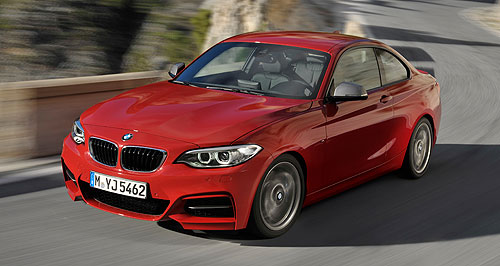Make / Model Search
New models - BMW - 2 Series - rangeBMW prices 2 Series hatchback from $50,500Take two: BMW’s new 2 Series coupe range steps up to an eight-speed automatic transmission across the three-variant line-up. Two-door, rear-drive BMW 2 Series coupe edges closer, pricing announcedGallery Click to see larger images 20 Jan 2014 BMW’s three-variant 2 Series compact rear-drive coupe range will kick off from $50,500 plus on-road costs when it arrives in March, $2500 more than its 1 Series predecessor. At launch, BMW will limit the 2 Series line-up to three variants: the 220i turbo-petrol, the $52,500 220d turbo-diesel and the $79,900 M Performance-tuned M235i six-cylinder coupe. The 2 Series, as the 1 Series Coupe replacement will be known, will lose the default six-speed manual gearbox that once set the entry point to the range at $48,000 for the 120i. Instead, all versions are now fitted with an eight-speed automatic transmission with paddles and launch control as standard, though a manual gearbox is listed as a no-cost option for buyers. It should be noted that the 120i automatic retailed for $50,695, making the 220i auto a cheaper proposition. The $2500 range hike mentioned comes about because the manual now costs the same as the auto, unlike before. At the other two specification levels, the 220d undercuts the (automatic) 123d it replaces by a hefty $8580. The M-badged flagship M235i is $1655 more expensive than the previous double-clutch automatic version, but has a 5kW power boost to 240kW. The Australian line-up will represent only half of the 2 Series variants that will be available to European buyers. Unlike us, they will also have the choice of a more powerful 228i petrol, more bowser-friendly 218d diesel, and a more powerful 225d diesel. Following in the wheel-tracks of its larger new 4 Series cousin – launched in Australia last October – the 2 Series adopts an even-number model name to give it clearer differentiation from the 1 Series hatch on which it is based. The name also references the classic BMW 2002 model line of the 1970s, as do the three-box proportions. The slinky design also reduces the aero rating to a slippery 0.29Cd. The 220i entry petrol uses a 135kW (between 5000-6250rpm) and 270Nm (between 1250 and 4500rpm) 2.0-litre TwinPower turbo engine that propels the car from 0-100km/h in 7.0 seconds and uses as little as 6.0L/100km of fuel on the combined cycle. The 2.0-litre turbocharged 220d has 135kW at 4000rpm and 380Nm between 1750 and 2500rpm and also manages to use as little as 4.4L/100km while sprinting from 0-100km/h in 7.1s. The one performance enthusiasts will no doubt be giving the eye is the 235i, which shares its 3.0-litre turbo inline-six with the M135i hatch, but offers even more power: 240kW (up 5kW) and 450Nm, with a sprint time from 0-100km/h as low as 4.8 seconds. The new model is a little larger than the outgoing 1 Series: length has increased by 72mm to 4432mm, width is up 32mm to 1774mm, the wheelbase grows by 3mm to 2690mm, front track width is up by 41mm to 1521mm and rear track width grows by 43mm to 1556mm. BMW also claims improved interior space, including 19mm of extra headroom in the front and 21mm of additional legroom in the rear, while boot capacity has increased by 20L to 390L, with 60:40 split/folding seats an option only. Signature elements such as rear-wheel-drive, longitudinally-mounted engines and 50:50 weight distribution all feature. Underneath the new body sits a double-joint spring strut front axle and five-link rear axle with “bespoke tuning” and electric power steering, while variable ‘sport’ steering, an M Sport braking system and an Adaptive M suspension setup with electronically controlled dampers are optional. On the topic of the bodyshell, the high-strength and torsionally stiff body structure is developed on the basis of the 1 Series. Safety equipment includes front, side and head airbags, pedestrian-friendly active bonnet and ‘defined front end deformation zones’. The cabin features a typical BMW driver-focused cockpit, with all versions getting as standard automatic climate control and an iDrive operating system in conjunction with BMW Professional radio or navigation with a flatscreen. Options – most of which will come to Australia – include an anti-dazzle High Beam Assistant, Adaptive Headlights, Parking Assistant, rear-view camera, Driving Assistant, Speed Limit Info with No Passing Info display, cruise control system with braking function, extended integration of smartphones and music players, Real Time Traffic Information, Online Entertainment, and extended functionality provided by apps for internet-based services such as Facebook and Twitter. GoAuto will bring you full local specification from the press launch to be held in late February. - With Barry Park.
 Read more9th of October 2013  Lexus to spank problem child CT into shapeFacelift to trigger repositioning of Lexus CT200h and reignite sales from next yearAll new models Alfa Romeo Alfa Romeo Abarth Abarth Alpine Alpine Alpina Alpina Audi Audi Aston Martin Aston Martin BMW BMW Bentley Bentley Chery Chery Brabham Brabham Chrysler Chrysler Chevrolet Chevrolet Cupra Cupra Citroen Citroen DS DS Dodge Dodge Fiat Fiat Ferrari Ferrari Foton Foton Ford Ford Great Wall Great Wall FPV FPV Haval Haval GWM GWM Honda Honda Holden Holden Hyundai Hyundai HSV HSV Isuzu Isuzu Infiniti Infiniti Jeep Jeep Jaguar Jaguar Lamborghini Lamborghini Kia Kia LDV LDV Land Rover Land Rover Lotus Lotus Lexus Lexus Maserati Maserati Mahindra Mahindra McLaren McLaren Mazda Mazda Mercedes-Benz Mercedes-Benz Mercedes-AMG Mercedes-AMG Mini Mini MG MG Nissan Nissan Mitsubishi Mitsubishi Pagani Pagani Opel Opel Porsche Porsche Peugeot Peugeot Ram Ram Proton Proton Rolls-Royce Rolls-Royce Renault Renault Saab Saab Rover Rover Smart Smart Skoda Skoda Subaru Subaru SsangYong SsangYong Tesla Tesla Suzuki Suzuki Toyota Toyota Volvo Volvo2 Series pricing
Motor industry news |
|
||||||||























Facebook Twitter Instagram